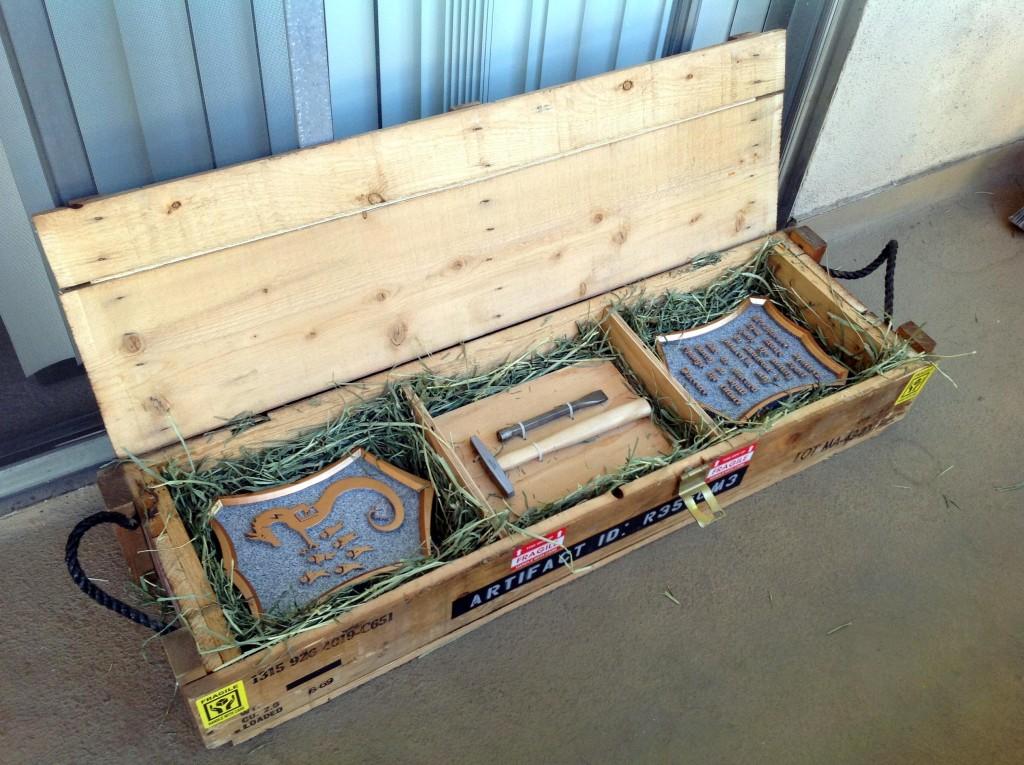 If you find drafting a résumé an impossibly arduous task, then imagine producing one in stone. While Mr. Deep Immersion, surely a candidate for some kind of Maker of the Year award, didn’t quite carve his most recent résumé in stone, he came pretty close.
If you find drafting a résumé an impossibly arduous task, then imagine producing one in stone. While Mr. Deep Immersion, surely a candidate for some kind of Maker of the Year award, didn’t quite carve his most recent résumé in stone, he came pretty close.
According to his blog, Mr. Deep Immersion (that’s the only name we have for him currently), a huge RPG (role-playing game) fan, wanted to apply for a job with Wizards of the Coast, a major player in the RPG industry based in Seattle. 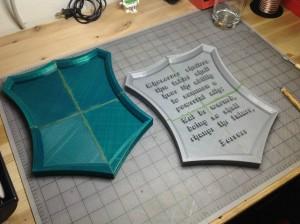 He wanted to impress them with not only his clearly extensive maker skills, but with his creativity and originality. I imagine that, additionally, they were impressed by this man’s work ethic, which is seemingly, well, rock solid.
He wanted to impress them with not only his clearly extensive maker skills, but with his creativity and originality. I imagine that, additionally, they were impressed by this man’s work ethic, which is seemingly, well, rock solid.
What Mr. Deep Immersion (henceforward, “Mr. D”) envisioned was a kind of RPG-inspired résumé from days of yore: A wooden crate containing a stele emblazoned with a golden dragon (demonstrating skills to tiny humans) crest. Hidden inside of the stele? A top-secret document containing a treasure map. Or Mr. D’s résumé.
Thus began one of the most impressive and detailed job application processes I’ve ever witnessed, although no sea crossings were involved. He designed a set of faux stone tablets using a couple of different materials by Smooth-On–Smash! Plastic and Quarry Tone–that would allow the fake granite to shatter when struck with a small hammer.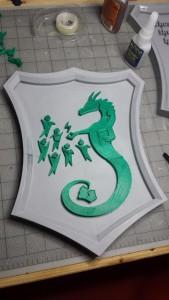
Mr. D designed the tablets using, in his words, “multiple CAD packages” and then sliced the models so they would fit on his print bed. He used his home-built 3D printer to produce the forms for the silicone molds in which he made the final tablets using a plastic material that, when dry, looks like granite and breaks apart a bit like concrete or brick.
But first things first.
Mr. D 3D printed the forms, including the dragon and puny human glyphs for one tablet, printed separately to be sanded to his satisfaction, and archaic-looking text on the other. He glued the different pieces together and then covered them with multiple layers of primer and then sanded until he got the smooth finish he was looking for. It was important for the form to be absolutely smooth so that the silicone molds would be as well. Finally, he sprayed the forms with a layer of clear sealant to achieve a glossy surface that would allow the molds to pull easily away from the forms.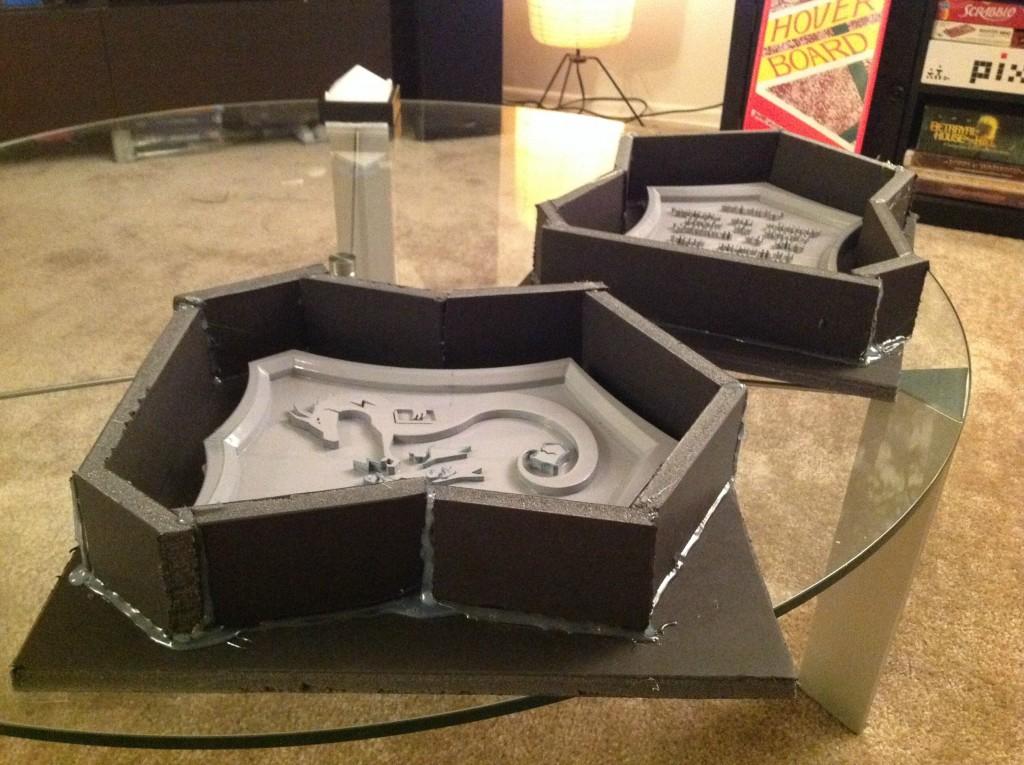
Next came the boxes in which the forms would go and in which the silicone would be poured. Note that, in addition to being incredibly detail-oriented, Mr. Deep Immersion is also very safety-minded, so this part of the process took place outside of the house. Evidently, the molds plus the boxes were quite heavy once cured, so there’s some relatively heavy lifting involved in a project like this as well.![]()
The tablets themselves are fairly heavy but you’d want that in an object designed to look just like stone (unless of course you’re into irony).
“The weight of the tablets,” recalled Mr. D, “actually matches that of stone! Most people will be very confused about how these were made when I am finished.”
Once the tablets were dry, he added the gold detailing to the glyphs. In designing them, he’d planned for their ultimate intent: concealing his résumé and business cards inside, sealed within each tablet so the only way to get to them would be to shatter the “stone.” As far as his résumé was concerned, Mr. D bought some sheets of handmade parchment paper, which he cut to feed into his printer and then printed his résumé onto them, finally folding them and sealing them with a glob of red wax before concealing a full copy within each of the two final tablets. They couldn’t really look more authentically ancient.
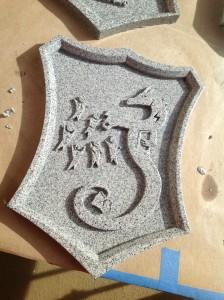 The final steps were every bit as creative as the preceding ones. Mr. D found a most unusual, extremely creative way to ship the faux stone tablets and the enclosed résumé. He got a wooden crate and made it look like a museum artifact shipping crate, including filling it with with hay from a local equestrian center to prevent the tablet from shattering before the big moment. While he’d intended to include a hammer to be used for breaking open the tablet, Mr. D realized that a hammer might invite a less refined approach to opening the sealed tablet so he also included a chisel, which seems to urge a bit of restraint.
The final steps were every bit as creative as the preceding ones. Mr. D found a most unusual, extremely creative way to ship the faux stone tablets and the enclosed résumé. He got a wooden crate and made it look like a museum artifact shipping crate, including filling it with with hay from a local equestrian center to prevent the tablet from shattering before the big moment. While he’d intended to include a hammer to be used for breaking open the tablet, Mr. D realized that a hammer might invite a less refined approach to opening the sealed tablet so he also included a chisel, which seems to urge a bit of restraint.
In the end, he made two tablets so that, after the first one was broken and its enthusiastic recipient (maybe a receptionist who wouldn’t actually have a say in the matter of hiring him) duly impressed, would urge the next person–hopefully the person doing the hiring–to give it a go.
“They both have the same contents, so that there are two identical tablets, total!” Mr. Deep Immersion explained of his duplicating approach. “The reason for sending a duplicate was super important! The first one that gets smashed is likely going to impress a single person (or very small group of people). They’re going to go ‘Holy cow! _______, head of _______ needs to see this!’ And then the original smasher brings tablet number 2 to an influential decision maker to expose them to the experience; thus, spreading the word! Exposure by design! 😀 Also redundancy…because I wouldn’t be surprised if one of these breaks in transit if UPS isn’t gentle as they say they are.”
Mr. Deep Immersion did not get a job at Wizards of the Coast as there were, he explained, “no available positions that meet my skillset.” However, the CEO of Wizards was so impressed with Mr. D’s résumé that he passed it on–I’m assuming sans the crate and pieces of the tablets–to several other companies. I am delighted to report that Mr. Deep Immersion evidently got a job and, presumably, one that lets him use his incredibly diverse skills and creativity. You can see his entire build process documented here on imgur, and check out more of his impressive designs on his Tumblr blog.

Subscribe to Our Email Newsletter
Stay up-to-date on all the latest news from the 3D printing industry and receive information and offers from third party vendors.
You May Also Like
3D Printing Unpeeled: New Arkema Material for HP, Saddle and Macro MEMS
A new Arkema material for MJF is said to reduce costs per part by up to 25% and have an 85% reusability ratio. HP 3D HR PA 12 S has been...
3D Printing News Briefs, January 20, 2024: FDM, LPBF, Underwater 3D Printer, Racing, & More
We’re starting off with a process certification in today’s 3D Printing News Briefs, and then moving on to research about solute trapping, laser powder bed fusion, and then moving on...
3D Printing Webinar and Event Roundup: December 3, 2023
We’ve got plenty of events and webinars coming up for you this week! Quickparts is having a Manufacturing Roadshow, America Makes is holding a Member Town Hall, Stratafest makes two...
Formnext 2023 Day Three: Slam Dunk
I’m high—high on trade show. I’ve met numerous new faces and reconnected with old friends, creating an absolutely wonderful atmosphere. The excitement is palpable over several emerging developments. The high...































